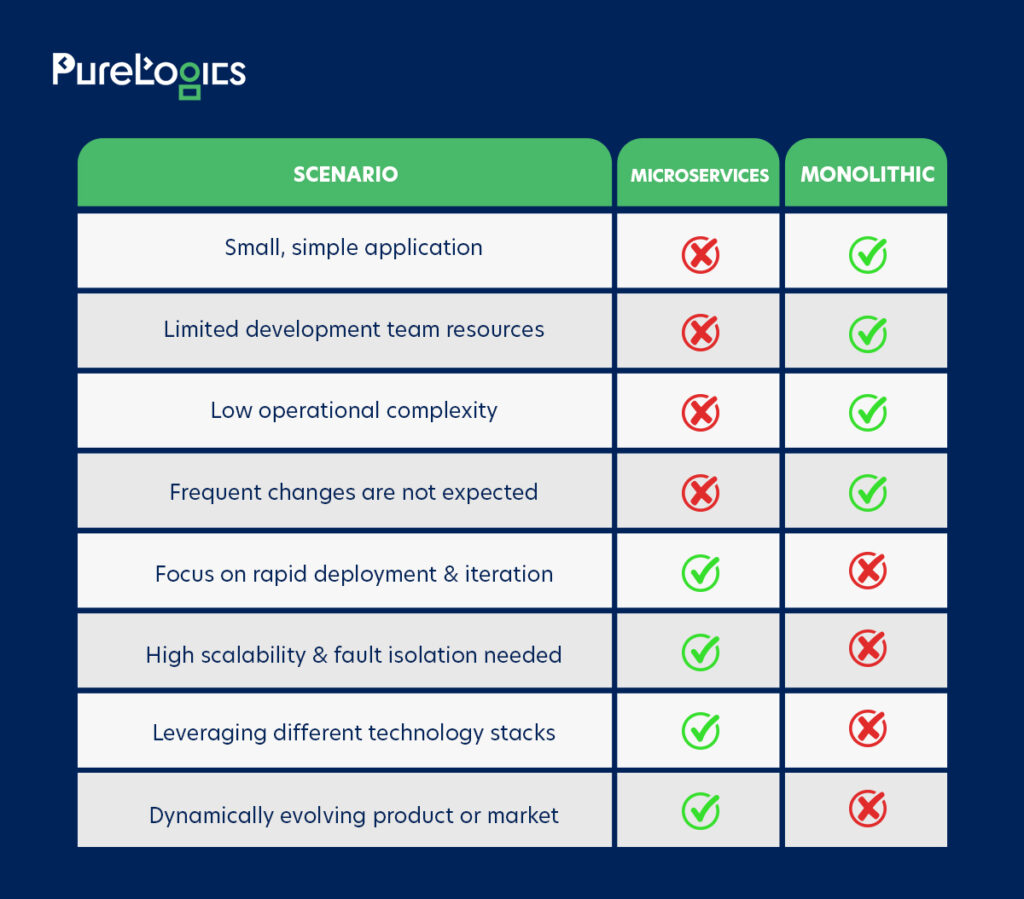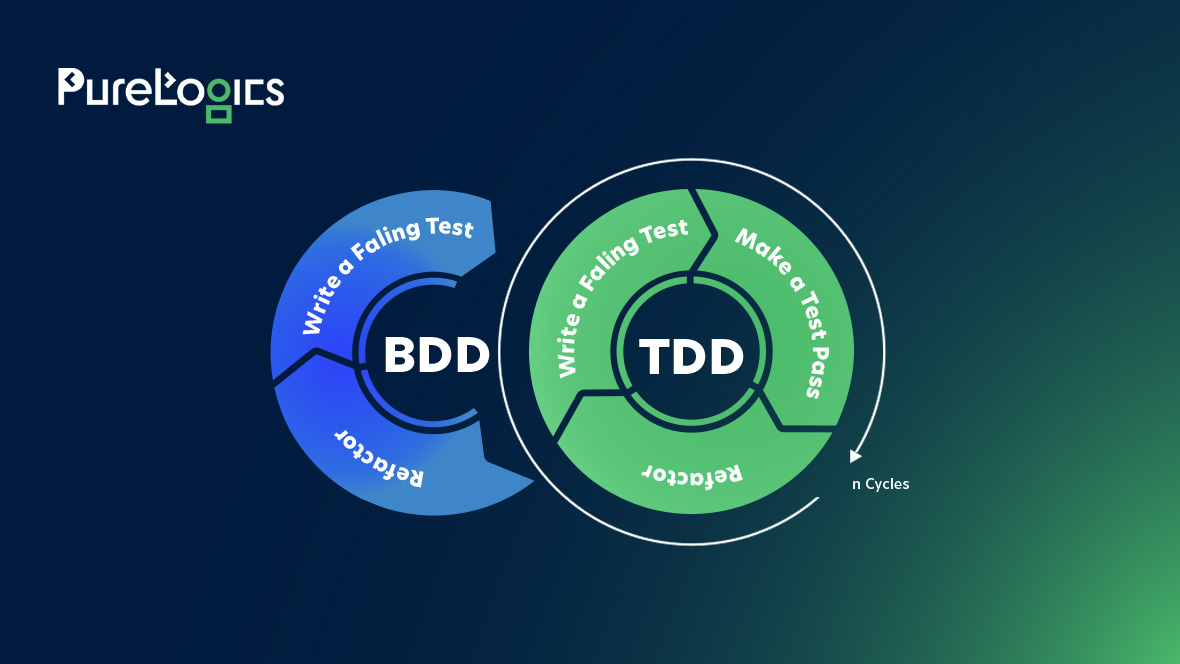In the software development industry, how you structure your app can leave a major impact on how it works and how seamless it is to maintain. Two common methods to structure software are known as microservices and monolithic architectures. In this blog, we’ll discuss key differences between these two frameworks and when you should choose one for your business model.
Microservices Architecture
An app is developed as a collection of independent, small services in a microservices architecture, each showcasing a unique business capability. All these services communicate with one another over a network and are loosely coupled, often utilizing lightweight protocols such as messaging queues or HTTP.
- Every service is responsive to one feature or functionality of the app and can be independently built, deployed, and scaled.
- This architecture has a major effect on the relationship between the database and the application.
- Rather than sharing a single database with multiple microservices, every microservices has their own database. It usually results in data duplication in a few cases. However, having a separate database for each microservice is crucial if you wish to benefit from microservices architecture, as it guarantees loose coupling.
The Pros of Adopting a Microservices Architecture
Here are the top pros of microservices architecture:
Scalability: Microservices allow individual parts of an app to be scaled separately based on demand. It means that you can only scale parts of your app that require tackling more traffic instead of scaling the whole application.
Resilience: As microservices are decoupled from one another, a failure in a single service doesn’t necessarily affect the entire application. This enhances the overall resilience of the app and lowers the risk of downtime.
Flexibility: Microservices allow teams to utilize various programming languages and technologies for different services depending on their unique needs. This flexibility lets teams select the best tool for the task rather than getting bound to one technology stack.
Agility: This architecture allows teams to build, test, scale, and deploy independently, enabling quicker development cycles and faster time-to-market for the latest features.
Technology diversity: Various services within a microservices architecture can utilize different frameworks, databases, and technologies based on their unique requirements. This enables greater innovation and flexibility in technology options.
Easier maintenance: It’s simpler to understand, advance, and maintain the codebase with microservices, and each service is shorter and focused on a unique functionality. This can result in faster debugging and development times.
Need Scalable Software Solutions?
Our software development services ensure seamless scalability and innovation for your business.
Potential Pitfalls of Microservices Architecture in Projects
Here are the common pitfalls of monolithic architecture:
Complexity: Maintaining a large number of microservices can be complicated. It needs careful coordination within teams and can be prone to a more complex monitoring and deployment environment.
Cost: Microservices can offer flexibility and scalability, but they can also add to costs, especially in operational overhead and infrastructures. Managing a wide range of services can require more investments in tools, infrastructure, and resources.
Testing: Testing these applications can be more difficult compared to monolithic apps. A detailed testing strategy is needed that encloses integration testing and unit testing between services.
Deployment complexity: Managing and deploying a large group of microservices can be challenging. It needs automated tools and a powerful deployment pipeline to ensure that all changes are deployed seamlessly without any downtime.
Tracking and debugging: Tracking and debugging microservices can be more complex compared to other monolithic apps since every service has issues, and tracing issues across various services independently can be difficult.
Increased overhead: There’s an overhead linked to maintaining communication within services, such as serialization/deserialization of data. This can also impact the application’s performance.
Monolithic Architecture
This architecture is a traditional strategy for designing software in which a complete application is developed as an invisible, single unit. In monolithic architecture, all the components of the app, like the business logic, data access layer, and user interface, are tightly deployed and integrated.
It means that any updates or changes to the app need redeploying and modifying the entire monolith.
This architecture is often categorized by its ease of development and simplicity, specifically for small to medium-sized organizations.
But, they can become quite challenging to manage as the complexity and size of the application increases.

The Pros of Adopting a Monolithic Architecture
Here are the top pros of monolithic architecture:
Simplicity: With this framework, all application codes are centralized. This makes it simpler to understand how various parts of your app work simultaneously. It simplifies the development procedure as developers don’t have to worry about how services communicate internally.
Development Speed: As all aspects of your applications are integrated tightly, it’s quicker to build new features. Developers can make updates to the codebase without worrying about disturbing other parts of the apps.
Deployment: Deployment of a monolithic app is simpler as you are only required to deploy a single artifact. It makes it simpler to maintain deployments and minimize the potential risk of deployment errors. Also, since all the code is centralized, it’s simpler to roll back updates if something goes south during deployment.
Debugging: Tracking and debugging problems in a monolithic application is easier to detect as everything is linked and is within a single place. Developers can utilize tools to track the flow of execution via the application, making it seamless to find and fix issues.
Potential Pitfalls of Monolithic Architecture in Projects
Here are the common pitfalls of monolithic architecture:
Complexity: With the growth of monolithic applications, it becomes challenging to manage them. This complexity makes it hard for developers to understand how various aspects of the application interact with each other, resulting in longer development cycles and a higher risk of errors.
Deployment: Deploying a monolithic app is a time-consuming and challenging process. As the whole application is deployed as one unit, any updates to the applications need deploying the entire monolith, which results in a longer deployment period and causes more danger of deployment errors.
Scalability: Monolithic apps can be difficult to scale, especially when specific components are required to handle a large number of traffic. Since all the application parts are tightly connected, scaling one part often requires scaling the entire app, leading to inefficiency and a costly process.
Technology Stack: Within a monolithic architecture, all components of the app share a single technology stack. It can restrict the flexibility of the development team, as they’re limited in utilizing the same technologies for all parts of the application.
Fault Tolerance: Within a monolithic architecture, there’s no isolation within components. This means that if one component fails, the entire application will fail. This insufficiency of fault tolerance can make monolithic applications more vulnerable to reliability and downtime issues.
Ideal Scenarios for Microservices and Monolithic Architectures
Both architectures come with their own set of operational benefits and challenges. Here are some of the best scenarios where you can use microservices or monolithic architecture:

PureLogics Insights to Migrate from Monolithic to Microservices Architecture
Many projects initially start as a monolith and then turn into a microservice architecture. With the addition of new features to the monolith, it may become cumbersome to have multiple developers working on one codebase. Code conflicts get more frequent, and the likelihood of updates to one feature introducing problems in an unrelated service increases. When these unwanted patterns arise, it’s time to contemplate migrating to microservices.
Here are a few of the best practices our experts at PureLogics have listed:
Map a Migration Strategy: It’s essential to dedicate a significant amount of time to deciding the sequence of migrating to microservices. Since every business has unique profiles and multiple usage dynamics once migrated, it’s crucial to plan accordingly.
Manage Expectations: An organization’s transformation needs a senior executive sponsor who’s responsible for results and is eager to enforce the necessary tradeoffs. The accountable person should allow the company to invest in new systems, tools, and processes to create permanent improvements. Additionally, it’s important to keep up transparent communications with the executive team, customers, partners, stakeholders, and the entire R&D team.
Tooling: The right tools are crucial when undergoing a migration from monolithic to microservices. It’s advised to take the process slow, first invest, and build tools for migration, taking it as a marathon rather than a sprint.
Adopt a Cultural Shift: Culture matters in such massive projects. It’s good to ensure that when there’s a problem, it’s percolated all the time. It’s not all technical migration when you start the migration process; rather, it is an organizational and people change.
Balance Trust and Speed: Lastly, it’s critical to ensure high performance and reliability. Build a system of checks & balances with expert engineers to manage reliability to ensure you meet high standards.
Need a Scalable Architecture for Your Next Project?
Our team can design and implement the perfect solution for your business.
Concluding Thoughts
If you’re developing a small project, then a monolithic architecture is like having all components in a single box, which can be simpler to manage initially. However, with the growth of a project, it’s like trying to multiple things into the same box, which can become more difficult.
Conversely, with a microservices architecture, you have multiple smaller boxes, each dealing with a unique aspect of your project. This makes it simpler to scale and manage as your project expands, but it needs additional coordination and planning to ensure all boxes simultaneously work together seamlessly.
The migration process can be quite daunting, so why not leave things in the experts’ hands? PureLogics is an expert in offering product development services. Our talented team can seamlessly take over your business migration processes. We guarantee to launch a successful development, deployment, and continuous maintenance of your projects. Contact us today for a free consultation!


 [tta_listen_btn]
[tta_listen_btn]
 September 13 2024
September 13 2024






